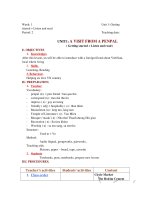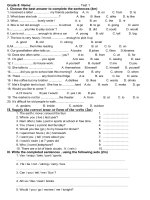English 8: Unit 1. Leisure Activities. Lesson 1. Getting started
Bạn đang xem bản rút gọn của tài liệu. Xem và tải ngay bản đầy đủ của tài liệu tại đây (1.32 MB, 31 trang )
<span class='text_page_counter'>(1)</span><div class='page_container' data-page=1>
Welcome to our class
</div>
<span class='text_page_counter'>(2)</span><div class='page_container' data-page=2>
Period 31
Unit 4:
OUR CUSTOMS AND
TRADITIONS
</div>
<span class='text_page_counter'>(3)</span><div class='page_container' data-page=3></div>
<span class='text_page_counter'>(4)</span><div class='page_container' data-page=4></div>
<span class='text_page_counter'>(5)</span><div class='page_container' data-page=5></div>
<span class='text_page_counter'>(6)</span><div class='page_container' data-page=6>
<b>gathering</b>
(n)
</div>
<span class='text_page_counter'>(7)</span><div class='page_container' data-page=7></div>
<span class='text_page_counter'>(8)</span><div class='page_container' data-page=8></div>
<span class='text_page_counter'>(9)</span><div class='page_container' data-page=9>
<b>conical hat</b>
(n)
</div>
<span class='text_page_counter'>(10)</span><div class='page_container' data-page=10>
<b>reflect</b>
(v)
</div>
<span class='text_page_counter'>(11)</span><div class='page_container' data-page=11>
<b>clockwise</b>
<sub>(adv)</sub>
<b>:</b>
<b><sub>kim đồng hồ</sub></b>
<b>theo chiều </b>
<b>≠</b>
<b>counter-clockwise</b>
<b>:</b>
<b>ngược chiều </b>
<b><sub>kim đồng hồ</sub></b>
</div>
<span class='text_page_counter'>(12)</span><div class='page_container' data-page=12>
-
<b>wealthy (a) : sung túc, giàu có</b>
<b>- gathering (n) : sự tụ họp, buổi họp mặt</b>
<b>- unity (n) : sự đoàn kết </b>
<b>- conical hat (n) : nón lá</b>
<b>- reflect (v) : phản ánh</b>
<b>- clockwise (adv): theo chiều kim đồng hồ </b>
<b>- ≠ counter-clockwise (adv): ngược chiều kim </b>
<b>đồng hồ </b>
</div>
<span class='text_page_counter'>(13)</span><div class='page_container' data-page=13>
<b>JUMBLED WORD</b>
<b>S</b>
<b>1. gnirhetag</b>
<b>2. ckeslcwio</b>
<b>3. cetlref</b>
</div>
<span class='text_page_counter'>(14)</span><div class='page_container' data-page=14>
<b>CHECKING</b>
<b>1. The xoe dance is a spiritual traditon </b>
<b>of Thai ethnic people.</b>
<b>2. There are 16 ancient forms of xoe.</b>
<b>3. Only young people perform the circle </b>
<b>dance.</b>
<b>4. Dances with conical hats, paper fans </b>
<b>or scarves are some forms of xoe.</b>
<b>5. The importance of xoe is expressed in </b>
<b>an old Thai song.</b>
<b>T</b>
<b>F</b>
<b>F</b>
<b>T</b>
<b>T</b>
<b>6 ancient forms</b>
<b>Young or old people</b>
</div>
<span class='text_page_counter'>(15)</span><div class='page_container' data-page=15>
<b>What is the tradition?</b> <b>The Xoe dance</b>
<b>What does the dance express? Working life and wishes for a </b>
<b>(1)______ life</b>
<b>Where do people perfom xoe ? Public and (2)_______</b>
<b>How many xoe dance forms </b>
<b>are there?</b>
<b>More than (3)________</b>
<b>What is the most popular?</b> <b>(4)_________</b>
<b>Why is it the most popular?</b> <b>It expresses (5)_____ unity</b>
<b>How do people perform it?</b> <b>Make a circle around the </b>
<b>(6)_____ and dance to (7)_____</b>
<b>Why should they continue this </b>
<b>tradition?</b>
</div>
<span class='text_page_counter'>(16)</span><div class='page_container' data-page=16>
<b> </b>
<b>What does the dance express?</b>
</div>
<span class='text_page_counter'>(17)</span><div class='page_container' data-page=17>
<b>Where do people perfom </b>
<i><b>xoe </b></i>
<b>?</b>
</div>
<span class='text_page_counter'>(18)</span><div class='page_container' data-page=18>
<b>How many </b>
<i><b>xoe</b></i>
<b> dance forms </b>
<b>are there?</b>
</div>
<span class='text_page_counter'>(19)</span><div class='page_container' data-page=19>
<b> </b>
<b>What is the most popular?</b>
</div>
<span class='text_page_counter'>(20)</span><div class='page_container' data-page=20>
<b>Why is it the most popular?</b>
</div>
<span class='text_page_counter'>(21)</span><div class='page_container' data-page=21>
<b>How do people perform it?</b>
*
<b>Make a circle around the _____ </b>
<b>and dance to _________</b>
</div>
<span class='text_page_counter'>(22)</span><div class='page_container' data-page=22>
<b>Why should they continue this </b>
<b>tradition?</b>
*
<b>Because it reflects Thai </b>
<b>_________________</b>
</div>
<span class='text_page_counter'>(23)</span><div class='page_container' data-page=23>
<b>What is the tradition?</b> <b>The xoe dance</b>
<b>What does the dance express? Working life and wishes for a </b>
<b>(1)happy and wealthy life</b>
<b>Where do people perfom xoe ? Public and (2)private gatherings</b>
<b>How many xoe dance forms </b>
<b>are there?</b>
<b>More than (3) 30</b>
<b>What is the most popular?</b> <b>(4) The circle dance</b>
<b>Why is it the most popular?</b> <b>It expresses (5) social unity</b>
<b>How do people perform it?</b> <b>Make a circle around the (6) fire</b>
<b>and dance to (7) the music</b>
<b>Why should they continue this </b>
<b>tradition?</b>
<b>It reflects Thai (8) culture and </b>
<b>lifestyle</b>
</div>
<span class='text_page_counter'>(24)</span><div class='page_container' data-page=24></div>
<span class='text_page_counter'>(25)</span><div class='page_container' data-page=25>
<b>1. express?</b> <b><sub>2. When?</sub></b>
<b>3. How </b>
<b>many </b>
<b>forms?</b>
<b>6. </b>
<b>continue? </b>
<b>Why?</b>
<b>5. </b>
<b>How to </b>
<b>perform?</b>
<b>4. </b>
<b>typical </b>
<b>form?</b>
<b>circle dance</b>
<b>make the circle , </b>
<b>move clockwise, </b>
<b>counter-clockwise</b>
<b>important </b>
<b>tradition, </b>
<b>reunite </b>
<b>with </b>
<b>families </b>
<b>honour their </b>
<b>ancestors</b>
<b>in mid-August in many regions of </b>
<b>Japan and in mid-July in other </b>
</div>
<span class='text_page_counter'>(26)</span><div class='page_container' data-page=26></div>
<span class='text_page_counter'>(27)</span><div class='page_container' data-page=27>
<b>1. express?</b> <b><sub>2. When?</sub></b>
<b>3. How </b>
<b>many </b>
<b>forms?</b>
<b>6. </b>
<b>continue? </b>
<b>Why?</b>
<b>5. </b>
<b>How to </b>
<b>perform?</b>
<b>4.</b>
<b>typical </b>
<b>form?</b>
<b>circle dance</b>
<b>make the circle , move clockwise, </b>
<b>counter-clockwise</b>
<b>important </b>
<b>tradition, </b>
<b>reunite </b>
<b>with </b>
<b>families </b>
<b>honour their </b>
<b>ancestors</b> <b>in mid-August in many regions of <sub>Japan and in mid-July in other </sub></b>
<b>regions</b>
<b>different </b>
<b>forms in </b>
<b>different </b>
<b>regions</b>
<b>OBON </b>
<b>DANCE</b>
</div>
<span class='text_page_counter'>(28)</span><div class='page_container' data-page=28>
<b>1. </b> <b>2.</b>
<b>3. </b>
<b>6. </b>
<b>5. </b> <b>4.</b>
<b>OBON DANCE</b>
<b>The Obon dance is a traditional Japanese dance. …….</b>
<b>People </b>
<b>should continue </b>
<b>this tradition </b>
<b>because it’s one of </b>
<b>the most important </b>
<b>traditions, many </b>
<b>people reunite with </b>
<b>families during </b>
<b>the festival </b>
<b>There are </b>
<b>different </b>
<b>forms in </b>
<b>different </b>
<b>regions</b>
<b>The Obon dance festival </b>
<b>takes place in mid-August </b>
<b>in many regions of Japan </b>
<b>and in mid-July in </b>
<b>other regions</b>
<b>People honour their </b>
<b>ancestors.</b>
<b>The most </b>
<b>typical form is </b>
<b>the circle dance</b>
<b> People make the </b>
<b> circle around a yagura, </b>
<b>a high wooden stage, some </b>
</div>
<span class='text_page_counter'>(29)</span><div class='page_container' data-page=29>
RETELL
</div>
<span class='text_page_counter'>(30)</span><div class='page_container' data-page=30>
Be ready for the new lesson:
Looking Back and Project
</div>
<span class='text_page_counter'>(31)</span><div class='page_container' data-page=31></div>
<!--links-->









